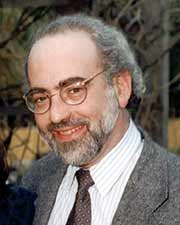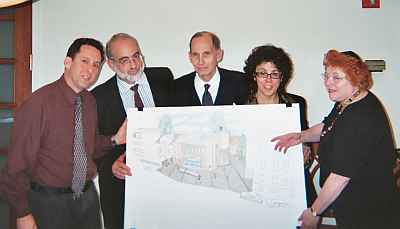 Arnold Oppler, Architect |
Mr. Oppler was born in New York City in 1957, the son of German émigrés. His late father, Edwin Oppler (19081986), fled Hannover, Germany, in 1939. After a short time in England, Edwin found refuge in New York City that same year. Arnold's late mother, Hildegard Simenauer Oppler (19261969), left the town of Horst-Emscher, Westphalia. Hildegard was rescued by the Jewish “Kindertransport” program in England and eventually emigrated to the United States.
Arnold Oppler is the great-grandson of Geheimer Baurat Edwin Oppler (18311880). Edwin Oppler was the architect of the synagogues in Hannover and Hameln (among others). Arnold and his second cousin Susan Oppler Wood are Baurat Oppler's only surviving descendents. They too, are the only descendents of other well-known and highly regarded Oppler artists, all of whom originated in Hannover. Two of Edwin Oppler's four sons became artists, painter Ernst Oppler (18671929) and sculptor Alexander Oppler (18691937). Ernst was a highly accomplished painter and etcher whose depictions of the Imperial Russian Ballet are especially well-known today. His work is in the collections of museums in Germany, the United States, and Israel. Alexander's works in stone and bronze were executed for prestigious public and private clients throughout Germany. Ernst and Alexander were trained at the Munich Academy and later established studios in Berlin where they became members of the well-known Berlin Secession, with other noted German artists of the day.
Arnold Oppler's grandparents, Sigmund Oppler (18731942) and Lilli Mendel Oppler (18851942), were prominent and active members of Hannover's Jewish community. As an attorney and notary, Sigmund was well suited to his role as manager of the grand Synagogue that his father, Edwin, had designed. Arnold Oppler's father, Edwin Oppler (named for his grandfather, the architect), had a growing reputation as a painter until his forced emigration from Germany. Like his uncles, Edwin studied art at the Munich Academy. He later studied in Italy and in Berlin under the noted German artist Eugen Spiro (18741972). Upon arriving in the United States, Edwin Oppler received a full scholarship to the Yale University School of Fine Arts. His parents were by then, living in Amsterdam under very tenuous conditions. Reluctantly, Edwin withdrew from Yale in an effort to financially support his parents whose situation grew increasingly perilous as the Nazi grip on Holland grew tighter. For the next forty-five years Edwin Oppler continued his work as a painter and art teacher in New York. He died in 1986, leaving a legacy paintings and drawings in a lyrical and expressive personal style of highly accomplished artist. One of Arnolds ongoing goals is to further expose his father's work to the art public.
 Architect Arnold Oppler displays his design for the proposed synaogue for Hamelin. From left to right are Robert Weinstein, Arnold Oppler, Warren Wechsler, Rachel Dohme, and Rabbi Jo David. |
Arnold Oppler's studies at the Rhode Island School of Design led to professional design degrees in architecture and industrial design. The simultaneous pursuit of degrees in these two distinct but related design fields reflects his keen interest in architectural and product details. His building designs reflect this dual interest a strong focus on craft and workmanship can be found in his projects where a architectural elements, large and small, are carefully detailed to achieve a unified and organic result.
With over twenty years of architectural experience, Oppler has worked with noted American architects Theodore M. Ceraldi, AIA, and Winthrop W. Faulkner, FAIA. Both Ceraldi's and Faulkner's offices have produced numerous awarded and highly regarded residential and institutional projects. Oppler played a key role in such projects within these offices. Inspired and trained by these two talented and productive architects, he established his own practice in 1998, which operates in New York State and Maryland and has completed numerous residential commissions. Working with other independent architect colleagues he has made important contibutions to the designs of various institutional projects. Oppler has been successful in melding his client's individual needs with appropriate, attractive, and functional solutions to their building programs.